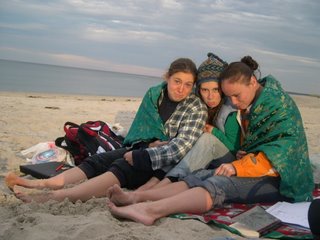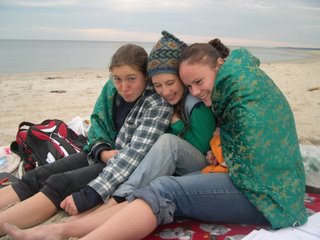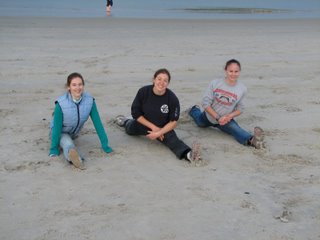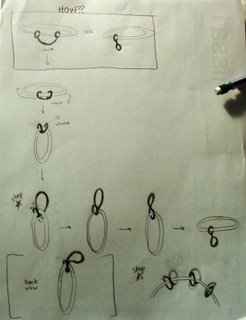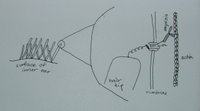History:
1. 700: Gregorian chant. Gregory is important because, although he didn't write any of the chant named after him, he collected and organized the many kinds of chant all around Europe in to the Ordo. Most of these chants were modal melodies.
2. 900: Guido D'Arezzo invents solfege and modal theory! Also, notation comes in to use.
3. Age of the crusades: violins are brought to Europe from the Middle East. Great cathedrals are built around Europe and organum comes in to practice (organum is an early form of polyphonic music, usually, the main melody was just translated down a 5th). There are several kinds of chant: Oblique (1 moving line and 1 drone), Parallel (like organum), and Contrary (counterpoint as we know it). Universities are built, double-entry book keeping and capitalism arise (I STILL don't know what this has to do with music).
4. By the Renaissance, Palestrina is composing. His music is studied by Johann Fux, who then writes the book "Gradus ad Parnassum" (Parnassus is the mountain where the muses live). This book categorizes Palestrina's music in to "species" of counterpoint. Counterpoint is defined as "the art of combining melodies that sound good together".
Counterpoint:
1. First species: notes are 1-against-1. Only consonances allowed (unison, 3rd, 5th, 5th, octave, 10th). Must start on 5th or octave, and end on octave. Can't have 2 skips in a row, no parallel 5ths or 4ths.
2. Second species: 1 line has twice as many notes as the other (half notes on whole note). Accented beats must have only consonances, unaccented beats may have dissonances but only if they are prepared and resolved by step.
3. Third species: 4 notes on 1 (quarter notes on whole note). We didn't do this one.
4. Fourth species: uses tons of suspensions. Can lapse in to 2nd species if necessary. Still can not jump to or from a dissonance.
Rhythmic Types:1. Compound triple meter (circle with dot) - 9/8 time signatures, example:
Jesu Joy of Man's Desiring
2. Simple triple meter (circle) - 3/4 time signature, example: Home On The Range
3. Compound duple meter (half circle with dot) - 6/8 and 12/8 time signatures, example: d minor
partita for solo violin,
Gigue movement, by Bach
4. Simple duple meter (half circle) - 2/4 and 4/4 time signatures, example: Pomp and Circumstance
Multimeter:1.
Rhythmic patterns such as " 123 123 12, 123 123 12" which repeat, and are therefore regular, but are not made out of homogeneous units, example: "America" from West Side Story.
2. Or,
rhythmic patters such as "1234 123 12345 1234567 12 123" which do not repeat and are not regular, example: "The
Firebird".
Polymeter:1. 2 regular meters that happen at the same time. For example, a pattern of 3 beats against a pattern of 2 beats, where each pattern takes the same length of time. One hand goes "1, 2" and the other hand goes "1, 2, 3". It sounds like: "do do-n-do" (1, 2(from triple)-2(from duple) 3).
Melodic Types:1. Conjunct, like "Ode to Joy", with few jumps
2.
Disjunct, like "The Star Spangled Banner", with lots of jumps
3. Phrasing: antecedent consequent phrasing, when the first phrase ends on a V chord, and the second phrase echoes the first in melody and length but ends on a I. Examples: "Oh Susannah", "My Bonnie", and "Home on the Range".
Musical Textures:1. Monophonic - only 1 melodic line, no harmony or counterpoint, examples: Gregorian chant, somebody whistling
2.
Homophonic - 1 dominant melody with supporting harmony that has approximately the same
rhythm, examples: traditional church hymns, a singer who is playing chords on a guitar to accompany himself
3. Polyphonic - contrapuntal music, rounds, canons, fugues (think Bach!), with more than 1
melody at once, example: "To The Greenwood", "One Day More" from Les
Mis,
4.
Heterophonic - rare in Western music!, 1 melody only, but simultaneous variations on it are happening
Musical Timbres:1.
Homogeneous - like a chorus, where everybody is creating one blended sound
2.
Heterogeneous - like a rock band, where each person sounds very distinct
Scales:1. The major scale (diatonic): interval structure goes like this:
WWhWWWh where W = whole step and h = half step.
2. The modes
a. Starting on "re": Dorian (
WhWWWhW)
b. Starting on "mi":
Phrygian (
hWWWhWW)
c. Starting on "fa": Lydian (
WWWhWWh)
d. Starting on "sol":
Mixolydian (
WWhWWhW)
e. Starting on "la": Aeolian (
WhWWhWW)
f. Starting on "ti":
Locrian (however, in common practice tonal music this is not used)
3. If you omit the half steps ("fa" and "ti") you get a pentatonic scale. You can do this in any mode.
4. Other words to describe scales:
a.
Hexatonic - 6 pitches
b.
Heptatonic - 7 pitches
c.
Octatonic - scale alternating between whole and half steps, there are two of these
d.
Anhemitonic - scale containing no half steps
e. Chromatic - scale with only half steps
f. Whole tone - scale with only whole steps
5. Scale degree names: tonic,
supertonic,
mediant,
subdominant, dominant,
submediant or
superdominant, leading.
Chords:1. In a major scale: I, ii, iii, IV, V, vi,
viio.
2. In a minor scale: i, ii0, III, iv, V(w/ raised leading tone), VI, VII.
3. Chord inversion:
a. For a triad: root position, 6 chord, 6/4 chord.
b. For a 7
th chord: root position, 6/5 chord, 4/3 chord, 4/2 chord.
4. Diminished triad: m3, m3. Augmented triad: M3, M3. Major triad: M3, m3. Minor triad: m3, M3.
Circle of Fifths:1. A fifths progression played on the piano comes out with the following chords: I, IV, vii, III, vi, ii, V, I. In C major the base line goes C, F, B, E, F, D, G, C.
2. The true circle of 5
ths in major keys (go down a minor third to get relative minor): C, G, D, A, E, B, F#, Db, Ab, Eb,
Bb, F. You get it backwards if you start in C and go by 4
ths.
Random Useful Information:
1. There are 7 half steps in a perfect 5
th.
2.
Plagal music is centered around sol of the key (like "Happy Birthday"). Authentic music is centered around do (like "Ode to Joy").
3. Components of a cantata (meaning "sung"): recitative, aria, chorus, and chorale.
